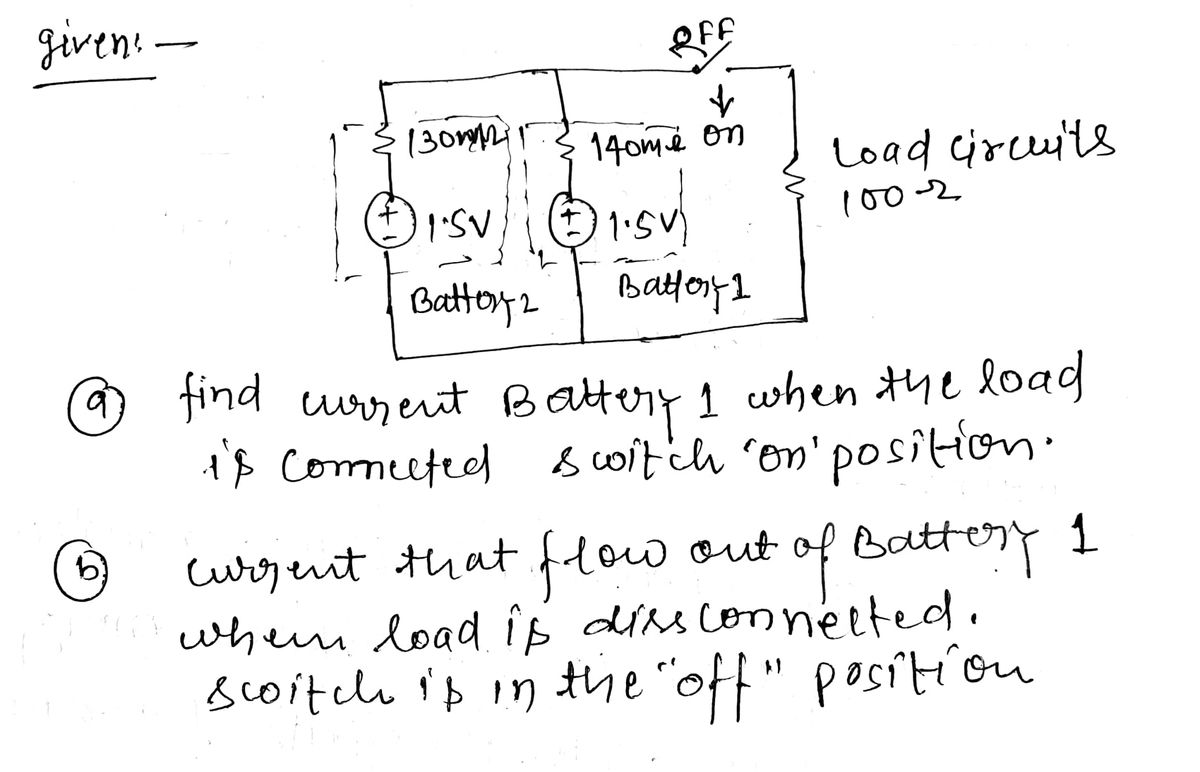circuit shows such an arrangement for a small consumer electronics device powered by two AA batteries. (a) Find the current that flows out of Battery 1 when the load is connected, i.e., the switch is in the "On" position. (We take "out of" the battery to mean current flowing out of the positive terminal.) (b) Find the current that flows out of Battery 1 when the load is disconnected, i.e., the switch is in the "Off" position. IntRes2 130mQ Chemistry2 1.5V Battery 2 IntRes1 140mΩ Chemistry1 1.5V Battery 1 Off ↓on LoadCircuits 1000 Hint: You can solve part (a) using KCL and Ohm's Law. Consider starting by labeling the current through, and the voltage across, the load. You can relate this to the currents through each of the batteries. Ultimately you should be able to obtain one equation for the load voltage. From that, you can determine all the currents.
circuit shows such an arrangement for a small consumer electronics device powered by two AA batteries. (a) Find the current that flows out of Battery 1 when the load is connected, i.e., the switch is in the "On" position. (We take "out of" the battery to mean current flowing out of the positive terminal.) (b) Find the current that flows out of Battery 1 when the load is disconnected, i.e., the switch is in the "Off" position. IntRes2 130mQ Chemistry2 1.5V Battery 2 IntRes1 140mΩ Chemistry1 1.5V Battery 1 Off ↓on LoadCircuits 1000 Hint: You can solve part (a) using KCL and Ohm's Law. Consider starting by labeling the current through, and the voltage across, the load. You can relate this to the currents through each of the batteries. Ultimately you should be able to obtain one equation for the load voltage. From that, you can determine all the currents.
Introductory Circuit Analysis (13th Edition)
13th Edition
ISBN:9780133923605
Author:Robert L. Boylestad
Publisher:Robert L. Boylestad
Chapter1: Introduction
Section: Chapter Questions
Problem 1P: Visit your local library (at school or home) and describe the extent to which it provides literature...
Related questions
Question
100%
Parts a & b pls.

Transcribed Image Text:4. Putting batteries in parallel allows them to act like one higher-capacity battery. The following
circuit shows such an arrangement for a small consumer electronics device powered by two
AA batteries.
(a) Find the current that flows out of Battery 1 when the load is connected, i.e., the switch
is in the "On" position. (We take "out of" the battery to mean current flowing out of
the positive terminal.)
(b) Find the current that flows out of Battery 1 when the load is disconnected, i.e., the
switch is in the "Off" position.
IntRes2
130mQ
Chemistry2
1.5V
Battery 2
IntRes1
140mQ
Chemistry 1
1.5V
Battery 1
Off
Von
LoadCircuits
1000
Hint: You can solve part (a) using KCL and Ohm's Law. Consider starting by labeling the
current through, and the voltage across, the load. You can relate this to the currents through
each of the batteries. Ultimately you should be able to obtain one equation for the load
voltage. From that, you can determine all the currents.
Expert Solution
Step 1

Step by step
Solved in 4 steps with 4 images

Knowledge Booster
Learn more about
Need a deep-dive on the concept behind this application? Look no further. Learn more about this topic, electrical-engineering and related others by exploring similar questions and additional content below.Recommended textbooks for you

Introductory Circuit Analysis (13th Edition)
Electrical Engineering
ISBN:
9780133923605
Author:
Robert L. Boylestad
Publisher:
PEARSON

Delmar's Standard Textbook Of Electricity
Electrical Engineering
ISBN:
9781337900348
Author:
Stephen L. Herman
Publisher:
Cengage Learning

Programmable Logic Controllers
Electrical Engineering
ISBN:
9780073373843
Author:
Frank D. Petruzella
Publisher:
McGraw-Hill Education

Introductory Circuit Analysis (13th Edition)
Electrical Engineering
ISBN:
9780133923605
Author:
Robert L. Boylestad
Publisher:
PEARSON

Delmar's Standard Textbook Of Electricity
Electrical Engineering
ISBN:
9781337900348
Author:
Stephen L. Herman
Publisher:
Cengage Learning

Programmable Logic Controllers
Electrical Engineering
ISBN:
9780073373843
Author:
Frank D. Petruzella
Publisher:
McGraw-Hill Education

Fundamentals of Electric Circuits
Electrical Engineering
ISBN:
9780078028229
Author:
Charles K Alexander, Matthew Sadiku
Publisher:
McGraw-Hill Education

Electric Circuits. (11th Edition)
Electrical Engineering
ISBN:
9780134746968
Author:
James W. Nilsson, Susan Riedel
Publisher:
PEARSON

Engineering Electromagnetics
Electrical Engineering
ISBN:
9780078028151
Author:
Hayt, William H. (william Hart), Jr, BUCK, John A.
Publisher:
Mcgraw-hill Education,